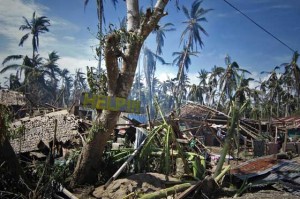Ruby (international name: Hagupit) weakened from a typhoon to a storm as it passed just south of Metro Manila on Monday, near the end of its slow journey across the central Philippines.
In the metropolis, evacuation efforts went into full swing as forecasters warned of heavy rain from dusk.
“We are on 24-hour alert for floods and storm surges . . . it’s the flooding that we are worried about,” Manila Mayor Joseph Estrada told Agence France Presse.
Thousands of people, mostly the city’s poorest residents who live in shanty homes along the coast and riverbanks, crammed into schools and other government evacuation centers across the metropolis on Monday.
Schools were also suspended, the stock market was closed, many office and government workers were told to stay at home, and dozens of commercial flights were cancelled.
The preparations were part of a massive effort led by President Benigno Aquino 3rd to ensure minimum deaths, after 7,350 people died when Super Typhoon Yolanda devastated large parts of the central Philippines in November last year.
Millions of people in communities that were directly in the path of Ruby over the weekend were sent into evacuation centers or ordered to remain in their homes.
The storm, the strongest to hit the Philippines this year with wind gusts of 210 kilometers an hour when it made landfall, caused massive destruction in remote farming and fishing towns.
But its winds were down to 85 kph to 100 kph on Monday afternoon and were expected to weaken further as it passed just south of Metro Manila in the evening, according to the Philippine Atmospheric, Geophysical and Astronomical Services Administration (Pagasa).
Pagasa said the winds were still capable of doing major damage to homes, and heavy rains were expected within the storm’s 450-kilometer-wide weather front.
Storm Signal Number 2 was up over Metro Manila, Batangas, Cavite, Bataan, Laguna, southern Quezon, Marinduque and northern Oriental Mindoro including Lubang Island.
Zambales, Pampanga, Tarlac, Bulacan, Rizal, Rest of Quezon, the rest of Mindoro and Romblon were under Signal No. 1.
Ruby is forecast to move west-northwest at 13 kph. It is expected to leave the Philippines on Wednesday evening.
Thousands of homes were destroyed, power lines were torn down, landslides choked roads, and flood waters up to one-storey high flowed through some towns.
Despite the damage, the government had by Monday morning confirmed just two deaths and there was widespread optimism that the intense focus on evacuations had saved many lives.
“All reports from affected areas have yet to come but we remain hopeful that more people have been spared,” presidential spokeswoman Abigail Valte told Agence France-Presse.
“The common factor between them is that preemptive evacuation was carried out and warnings by authorities were taken seriously.”
In Tacloban, a city of 220,000 people that was one of the worst-hit during Yolanda, authorities said there were no casualties over the weekend despite fierce winds that destroyed homes.
Valte said the President, who was following the situation from Bahay Pangarap, his official residence across the Pasig River from Malacañang, was in touch with key government officials on the ground through satellite phone.
Asked how Ruby impacted the rehabilitation efforts for Yolanda victims, Valte said the Office of the Presidential Adviser on Rehabilitation and Recovery under Secretary Panfilo Lacson will be making a report soon.
Metropolitan Manila Development Authority (MMDA) Chairman Francis Tolentino said response teams were deployed in the north, south, east and west sections of Metro Manila.
Tolentino said at least 17,000 food packs have been prepared for families that will be affected by the storm.
The National Disaster Risk Reduction and Management Council (NDRRMC) chief Alexander Pama earlier warned on Monday the entire metropolis would experience floods in a matter of hours if Ruby dumped heavy rains.
Rainwater flowing from the Sierra Madre and other mountainous areas during the past few days could aggravate the floods, Pama said.
He said that based on verified and validated reports, there were only two deaths related to Ruby.
The two fatalities were identified as one-year-old Theo Rojo, and Ernesto Baylon, 65, both from Iloilo province.
The NDRRMC said 232,948 families or 1,074,080 persons were affected by the typhoon.
Ruby is expected to be 60 km west northwest of Calapan City, Oriental Mindoro, on Tuesday morning and 335 km west of Calapan by Wednesday.
It is forecast to exit the Philippine area of responsibility by Thursday.
AFP, RITCHIE A. HORARIO, WILLIAM B. DEPASUPIL AND JOEL SY EGCO


